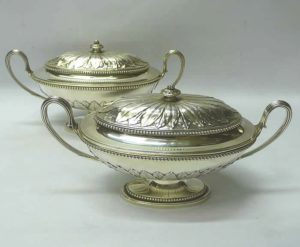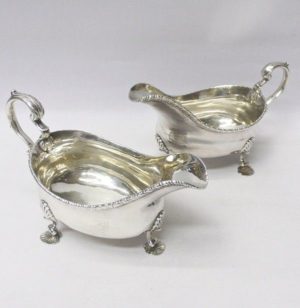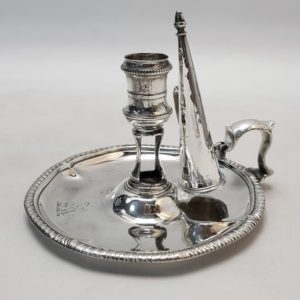Thomas Heming
Thomas Heming was apprenticed to Edmund Bodington on March 7, 1738, and turned over on the same day to the Huguenot goldsmith Peter Archambo. In 1745 Thomas Heming entered his first mark. Heming rose to prominence in 1760 with his appointment as Principal Goldsmith to King George III, in which capacity he was responsible for supplying regalia and plate required for the coronation. Heming held this appointment until 1782, when he was ousted after an investigation into his apparently excessive charges. Grimwade (1976, p. 543) comments that “some of his earlier surviving pieces in the Royal collection show a French delicacy of taste and refinement of execution which is unquestionably inherited from his master Archambo.”
It was Lord Bute, one of Heming’s most important patrons, who encouraged this significant new appointment. Heming was the first working goldsmith to hold this post since the early seventeenth century and the majority of pieces were made in his own workshop. The superb quality and refined delicacy of many of the items reflect the influence of Peter Archambo.
Thomas Heming
Thomas Heming was apprenticed to Edmund Bodington on March 7, 1738, and turned over on the same day to the Huguenot goldsmith Peter Archambo. In 1745 Thomas Heming entered his first mark. Heming rose to prominence in 1760 with his appointment as Principal Goldsmith to King George III, in which capacity he was responsible for supplying regalia and plate required for the coronation. Heming held this appointment until 1782, when he was ousted after an investigation into his apparently excessive charges. Grimwade (1976, p. 543) comments that “some of his earlier surviving pieces in the Royal collection show a French delicacy of taste and refinement of execution which is unquestionably inherited from his master Archambo.”
It was Lord Bute, one of Heming’s most important patrons, who encouraged this significant new appointment. Heming was the first working goldsmith to hold this post since the early seventeenth century and the majority of pieces were made in his own workshop. The superb quality and refined delicacy of many of the items reflect the influence of Peter Archambo.
-


1779
Thomas Heming
7377 George III Silver Sauce Tureens
Sold
An excellent quality pair of antique sterling silver tureens of small size. With classic boat shape and bead borders these lovely tureens have an entwined leaf design to both tops and covers and engraved crests to the front. Gilded inside. Beautifully made with a small piece cut for the serving ladle. Weight 1447 grams, 46.5 troy ounces. Height 13 cms. Spread 25 cms. Top edge 18.25 x 10.5 cms. London 1779. Maker Thomas Heming.
-


1764
Thomas Heming
8159 George III Silver Sauceboats
Sold
A handsome pair of antique sterling silver sauceboats with classic plain style typical of the period. With a broad band of gadroon edging, acanthus leaf handle and sitting on chunky shell feet. Each with a hand engraved crest to one side. Very good weight and large size. Each contains 330 ml. Total weight of pair 757 grams, 24.3 troy ounces. Spread 21 cms. Height 12.6 cms (to top of handle). Width 10.25 cms. London 1764. Maker Thomas Heming.
-


1765
Thomas Heming
10148 George III Antique Silver Chamberstick
Sold
An antique silver chamber stick (also known as a go to bed) of plain design with gadroon borders. Hand engraved with a lion crest to the top of the pan and candle snuffer. Weight 296 grams, 9.5 troy ounces. Height 9.1cm. Diameter 14.6cm. London 1765. Maker Thomas Heming, Principal Goldsmith to King George III. Sterling silver.